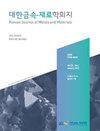外加阴极电流对汽车用超高强度钢的氢注入、脆化和腐蚀诱发氢脆化行为的影响
IF 1.4
4区 材料科学
Q4 MATERIALS SCIENCE, MULTIDISCIPLINARY
引用次数: 1
摘要
研究了电镀锌条件(电镀电流和时间的组合)对超高强度钢的氢注入、脆化和腐蚀诱发氢脆(HE)行为的影响。采用了一系列的实验和分析方法,包括电化学阻抗谱、氢渗透、极化和慢应变速率测试。结果表明,电镀锌过程中施加的阴极电流密度与锌的晶粒度成反比。较小的阴极电流密度和较长的电镀时间导致较大的晶体尺寸,导致较高的氢原子注入速率和HE敏感性(即,断裂表面二次裂纹密度较大的机械退化)。另一方面,当暴露于中性水性环境时,较大的阴极电流密度和较短的电镀时间导致较高的阳极溶解速率和较小的涂层极化电阻。因此,涂层和暴露的钢基体(例如,涂层周围的局部损坏区域)之间较高的电偶腐蚀速率导致较高的氢原子注入速率和HE敏感性。这项研究深入了解了在超高强度钢上进行电镀锌所需的电镀条件,该钢具有增强的抗氢注入和水腐蚀引起的脆化性能。本文章由计算机程序翻译,如有差异,请以英文原文为准。
Effects of Applied Cathodic Current on Hydrogen Infusion, Embrittlement, and Corrosion-Induced Hydrogen Embrittlement Behaviors of Ultra-High Strength Steel for Automotive Applications
The effects of the electrogalvanizing conditions (a combination of plating current and time) on hydrogen infusion, embrittlement, and corrosion-induced hydrogen embrittlement (HE) behaviors of ultra-high strength steel were examined. A range of experimental and analytical methods, including electrochemical impedance spectroscopy, hydrogen permeation, polarization, and slow strain rate test, were employed. The results showed that the applied cathodic current density during electrogalvanizing had an inverse relationship with the Zn crystalline size. A smaller cathodic current density and longer plating time led to a larger crystalline size, resulting in a higher infusion rate of hydrogen atoms, and HE-sensitivity (i.e., mechanical degradation with larger density of secondary crack in fracture surface). On the other hand, a larger cathodic current density and shorter plating time caused a higher anodic dissolution rate and smaller polarization resistance of the coating when exposed to neutral aqueous environments. Hence, a higher rate of galvanic corrosion between the coating and exposed steel substrate (e.g., locally damaged areas around coating layer) resulted in a higher infusion rate of hydrogen atoms and HE-sensitivity. This study provides insight into the desirable plating conditions for electro-Zn plating on ultra-high strength steels with enhanced resistance to hydrogen infusion and embrittlement, induced by aqueous corrosion.
求助全文
通过发布文献求助,成功后即可免费获取论文全文。
去求助
来源期刊

Korean Journal of Metals and Materials
MATERIALS SCIENCE, MULTIDISCIPLINARY-METALLURGY & METALLURGICAL ENGINEERING
CiteScore
1.80
自引率
58.30%
发文量
100
审稿时长
4-8 weeks
期刊介绍:
The Korean Journal of Metals and Materials is a representative Korean-language journal of the Korean Institute of Metals and Materials (KIM); it publishes domestic and foreign academic papers related to metals and materials, in abroad range of fields from metals and materials to nano-materials, biomaterials, functional materials, energy materials, and new materials, and its official ISO designation is Korean J. Met. Mater.
 求助内容:
求助内容: 应助结果提醒方式:
应助结果提醒方式:


